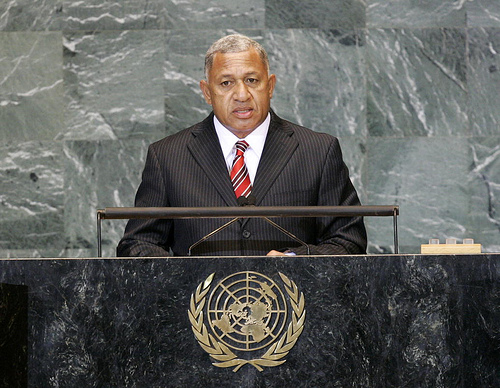As we come to grips with the aftermath of Cyclone Pam, Australia’s closely coordinating its initial response efforts with a range of capable responders: Britain, France, NZ and the United States. But in the days to come, supporting a Pacific regional response as well would have both humanitarian and wider benefits.
In 2011, Anthony Bergin and Richard Herr warned that Australia’s standing in Pacific regional affairs was eroding fast. The bitter intra-regional dispute with Fiji; growth of sub-regional bodies such as the Melanesian Spearhead; faltering support for our lead on specific initiatives; frustration with the stalled 2005 Pacific Plan for regional integration; rising influence of non-traditional partners (especially via alternative development models and funding options offered by China); and Island countries choosing to caucus in UN bodies that exclude us, were all harming the sort of collective decision-making and diplomacy that had served South Pacific—and our—interests well for decades.
After Island leaders endorsed a new Framework for Pacific Regionalism as the successor to the Pacific Plan last July, Fiji held a free and fair election in September, and the formidable Dame Meg Taylor took leadership of the region’s foremost political body—the South Pacific Forum—in November, optimists might have imagined things were looking-up.
So a fresh warning by another leading Pacific scholar that many neighbouring countries beside Fiji remain deeply dissatisfied with current regional architecture (and our place in it) is a worry. Greg Fry argues that Suva’s return to the Forum and the revival of Pacific regionalism are far from assured. He traces the establishment of the Forum in 1971 to Pacific leaders’ struggle to gain control of the technocratic South Pacific Commission (now the Secretariat of the Pacific Community) from Australia, France, NZ, the UK and the US. And he suggests Canberra and Wellington need to recapture both the spirit and the formula through which we initially cemented our place in an organisation some intended to exclude former colonial powers. Specifically, we should embrace a ‘patchwork architecture’ of complementary rather than competing regional organisations; work with neighbours to weave greater coherence and efficiency into such a system, based on a reformed Forum; provide Islanders more space to ‘chart their own course’ by ‘stepping-back’ from dominant roles; update Forum funding models to promote a greater sense of ownership; and encourage Island leaders to ‘step-up’ to more vigorous political debate.
To my mind, he makes a number of crucial points—especially that the existence of multiple regional bodies has advantages as well as drawbacks for dealing with thorny issues like West Papua; that the Forum offers the best basis for revitalised regionalism; and that, to attract followers, Australia must prove it’s a leader that listens. But I’m not entirely convinced recapturing the spirit of 1971 is feasible.
Fiji appears to have moved beyond a ‘Pacific Way’ doctrine that owed more to the hierarchical, elite-driven and conservative Polynesian side of its character than the highly competitive, personalised, and fragmentary rough-and-tumble of its Melanesian side. For Australia’s part, we now emphasise economic-cooperation in partnership with near neighbours, rather than donor-recipient relationships or the ‘tough-love’ language of the 2003-07 More Interventionist Approach but, in an era when our diplomats are expected to use aid to advance national interest as a matter of policy, it’s hard to imagine our providing the sort of hands-off support we might have 45 years ago.
As for other neighbours, there may be a sense Australia’s so attuned to Fijian sensitivities it has a tin-ear for wider feelings. There was weak support for, and some strong opposition to, the now indefinitely postponed summit Canberra and Suva proposed to discuss regional architecture. After all, the New Framework focuses on precisely the issue of Island leaders’ ownership of Pacific regionalism. Suva has also offended many usual allies across a range of issues, to the point where it’s probably more isolated than Canberra.
It would, however, be a mistake to regard the current impasse with any satisfaction or as a signal to resume business as usual. PM Bainimarama is unlikely to turn up at the next Forum leaders’ meeting in Port Moresby without some form of healing first. And although the level of friction between most members of the Forum can be overstated, a Forum without Fiji looks like ASEAN without Indonesia.
If the politics make summitry unworkable, perhaps we need to look to practical avenues for reviving habits of cooperation. Here, Cyclone Pam’s devastation of Vanuatu and damage to Tuvalu, Kiribati, and Solomon Islands may offer a circuit-breaker, as Fijian participation in a Forum-led regional response to such a shared tragedy could hardly be criticised. It’d be consistent with past calls for regional peacekeeping and disaster-response capabilities that, although impractical as a standing force, would be useful on an as-required basis. Given the level of destruction, even members who could contribute only manpower would be able to assist with reconstruction and community assistance. Australia and Fiji could each offer expertise and leadership without tussling for control. A regional response would also spur exchange on difficult climate change and labour mobility issues.
A restored Pacific regional settlement would have significant human-security benefits, including resilience in one of the world’s most disaster-prone regions. Those wanting to contribute to relief efforts on a personal level can consider various sites including this one.
Karl Claxton is an analyst at ASPI. Image courtesy of Flickr user United Nations Photo.


